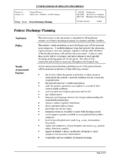Transcription of HOW TO OPTIMIZE YOUR HOSPITAL CASE MANAGEMENT …
1 HOW TO OPTIMIZE YOUR HOSPITAL case MANAGEMENT MODELD espite the best intentions of leadership, many case MANAGEMENT models in place today fail to efficiently serve the best interests of patients, staff, or the organization. That s because most institutionalized models were formed over time, with incremental amendments and modifications made in reaction to changes in healthcare economics, outside pressures from payers and legislation, and shifts in system leadership. Unfortunately, the ever-evolving, ad-hoc approach has resulted in a variety of unintended practical terms, most models will work well when optimized and applied to the right environment and staffed correctly. HOSPITAL leadership teams need to take proactive steps to understand why and when to choose one structure over another.
2 To do so, they should consider common obstacles that hinder success, and adhere to best practices for implementing and sustaining a model specially designed for their organizational OF case MANAGEMENTU tilizationManagementCareCoordinationCare TransitionsDischargePlanning /Psycho-SocialCase MANAGEMENT in hospitals is meant to help ensure patients receive the appropriate level of care through admission and transition. This includes an effective care plan, prescribed treatment, and an advocate during and after HOSPITAL stay. In most hospitals, the case MANAGEMENT function comprises utilization MANAGEMENT , care coordination, and discharge planning. Directors oversee the functions and assign duties by role to nurses and social hospitals currently structure their case MANAGEMENT departments around one of two theoretical best-practice models, making modifications based on perceived needs and limitations.
3 These include: Integrated (dyad) model, in which a single manager is responsible for overseeing all three functions for a given patient. Collaborative (triad) model, in which each function is assigned to a separate practice, few hospitals purely use the integrated or triad model, but a hybrid of both. In addition, they also consider other factors when assigning and deploying these models, such as geography, unit and physician MANAGEMENT leaders must also manage outside forces, including economics, legislation, payer structures, labor force, and patient population shifts. These aspects will often influence and dictate specific procedures, policies, and objectives for the case MANAGEMENT practice within an , one of the most critical and challenging factors for high performance remains within leaders immediate purview: the MANAGEMENT and role delineation of nurses and social workers when shared skills and duties, including a variety of nonclinical functions, must be performed.
4 Unfortunately, as a byproduct of growing budgetary constraints, over time case MANAGEMENT departments began increasingly leveraging these two specializations s: Early on, CMS requirements for UR and Discharge Planning led to two separate functions1980 s: DRG s with fixed payments created a needto mange care better and integrate functions 1990 s: Increasing clinicalcomplexity led to a shift insome DCP functions to RN s *Adapted from Core Skills for HOSPITAL case ManagersUtilizationReview*DischargePlann ing ledby SocialWorkersUtilizationManagement,Coord inationand Facilitationof Care*DischargePlanning RegisteredNurse CaseManager:AdditionalDCP role*SocialWorker:Focus moreon Psychosocial,interventionsand some DCPW hile it is true the two disciplines share some overlap in skill sets for the needs of hospitals, it has proven imprudent to disregard the distinctions of the disciplines and delineate roles accordingly.
5 In fact, doing so causes tension between the two roles because it is unclear who is responsible for what and why, and, in worst case scenarios, can weaken the quality of care patients , nursing and social work were far more discrete, and worked in tandem as siloed disciplines or, sometimes, as hand-off relays, rather than as collaborators on a patient s continuous treatment s worth noting nurses and social workers bring converging perspectives that tends to frame how they approach case MANAGEMENT : Nursing emphasizes the treatment of patients physiological needs, medical, therapeutic, diagnostic, and self-care education. Social work emphasizes treating patients psychological and social well-being needs, support system, continuity of care, and community it s a given that hospitals need nurses and social workers in order to provide patients with the best possible care and attention, it s far less understood or put into practice how to accommodate and leverage the distinct skill sets of each vocation to achieve a high-functioning case MANAGEMENT model.
6 And, while both nursing and social work disciplines clearly play an important role, the power balance often is uneven. 3In current HOSPITAL settings, three factors tend to give preference to the nursing perspective in case MANAGEMENT : 1) patients immediate physiological needs are the priority, 2) as such, nurses far outnumber social workers in case MANAGEMENT usually by a margin of five to two, according to the American case MANAGEMENT Association, 3) and those with backgrounds in nursing currently tend to oversee case fact remains that patients need both physiological and psycho-social care; thus, the specializations of both nurses and social workers are critical to the success of a HOSPITAL s case MANAGEMENT practice. Plus, as the healthcare industry continues to put more incentives on hospitals to reduce readmission rates, that power balance will become more even, as more emphasis will be put on discharge planning to address psycho-social issues known to spur readmission rates, increasing the need for social work within HOSPITAL the same time, these case managers specializing in social work will face the same pressures as nurses before them to expedite patient care plans and transitions, without endangering recovery or triggering readmission.
7 In other words, case MANAGEMENT teams will continue to be asked to do more, ever-faster, across complex patient population needs. Consequently, it is crucial for organizations to put effective and efficient tailored case MANAGEMENT models in PRACTICES TO OPTIMIZE AND TAILOR case MANAGEMENT MODELST heoretically, any case MANAGEMENT model can work well when applied to the right environment with a healthy culture. But that can only happen if HOSPITAL leadership teams understand why and how to choose, create, and implement a model that fits their organizational needs and patient population. Determining the best model for an organization depends on many factors, including: Organizational goals and focus Size of organization Product lines Payer mix Labor force Staffing patterns Length of stay case mix index (CMI)
8 Technology PhysiciansBy undergoing a care transition assessment, administrators and clinicians can improve their case MANAGEMENT models, create a high-performing, aligned team, as well as define and build a mutually agreeable strategic plan for implementing the new model and sustaining success assessment works by effectively bringing together cross-functional teams to hold open, honest discussion around the pros and cons of the in-use model, identify case MANAGEMENT needs, functions, and responsibilities, and build consensus on how to improve the in-use model based on patient and organizational needs. Together, the cross-functional team reviews patient care standards, organizational procedures and guidelines, and patient populations breakdowns being served by case MANAGEMENT .
9 In addition, nurses and social workers go through exercises together in which they: Identify and define the unique skill sets of each profession, especially in relation to the needs of case MANAGEMENT Identify unique patient populations best served by each discipline Align each step and task associated with the fulfillment of case MANAGEMENT to the specialization that best serves it or to the unique patient populations in need of itThe output of these exercises is mutually understood and agreed upon roles and responsibilities, based objectively on specialization and patient population needs. The results should also be carried into onboarding programs and regular staff touchpoints to reinforce and foster mutual respect and your performance and modelReview outcomesand refineCompare patientcare standards todepartmentstandardsDetermine ability tomeasure departmentstandardsClarify roles to ensureaccountability tostandard workDetermine how clearroles are betweenteam membersEnsure availability ofreports anddashboards tomeasure standards 2018, 2020 Guidehouse Inc.
10 All Rights Reserved. This material was originally published in 2018 and has been updated only to reflect information about Guidehouse. W51871 Guidehouse Inc. f/k/a Navigant Consulting, Inc. ( Guidehouse or Navigant ) is not a certified public accounting or audit firm. Navigant does not provide audit, attest, or public accounting services. See for a complete listing of private investigator publication is provided by Navigant for informational purposes only and does not constitute consulting services or tax or legal advice. This publication may be used only as expressly permitted by license from Navigant and may not otherwise be reproduced, recorded, photocopied, distributed, displayed, modified, extracted, accessed, or used without the express written permission of BRAGGD irector + TERRI JENNINGS Associate Director + About Guidehouse Guidehouse is a leading global provider of consulting services to the public and commercial markets with broad capabilities in MANAGEMENT , technology, and risk consulting.









